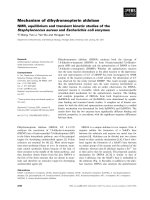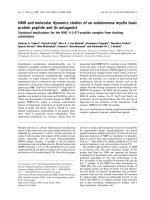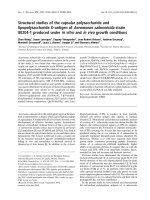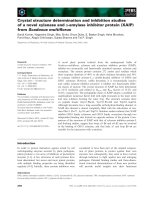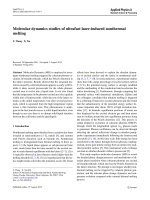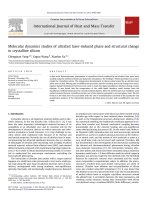Molecular genetic studies of fragile x syndrome and spinocerebellar ataxia type 2
Bạn đang xem bản rút gọn của tài liệu. Xem và tải ngay bản đầy đủ của tài liệu tại đây (1.48 MB, 130 trang )
ACKNOWLEDGEMENTS
I would like to express my sincere gratitude to all those who gave me the
possibility to complete this thesis.
The first person I would like to thank is my supervisor, Associate Professor
Samuel Chong, for his broad and profound knowledge, for his detailed suggestions and
patient instructions, and for his warm smile and strong support. He could not even realize
how much I have learnt from him.
I would like to express my appreciation to all SSC lab mates, both present and
past: to Arnold, who always offered his hand to me from my first day till now; to Felicia,
who remembered my birthday every year; to Zeng Sheng, who trouble shot my Southern
blot; to Liang Dong, who picked me up at the Airport on my first day; to Ya yun, who
handled the purchase order; to Hai Bo, who extracted good quality DNA; to Wang Wen,
who accompanied me in the small room after office hour; to Ben Jin, who cheered me up
during boring experiments; to Xiao Tao, who brought back delicious food; to Jane, Chin
Yan, Siew Hong and Hai Dong, who brought happiness to the lab.
Away from the lab, I want to thank Dr. Caroline Lee and Tang Kun from
Department of Biochemistry (NUS) for their interesting and valuable suggestions in the
fragile X haplotype analysis. I would like to thank Lily from Molecular Diagnostic Center
(NUH) for her StB12.3 probe. I would also express thanks to Celeste and Hong Keat for
their help in the haplotype genotyping experiments.
Last but certainly not least, I want to devote this thesis to my parents, for their love
and encouragement throughout my life.
i
TABLE OF CONTENT
ACKNOWLEDGEMENTS .................................................................................................. i
TABLE OF CONTENT ....................................................................................................... ii
LIST OF FIGURES AND TABLES................................................................................... iv
ABBREVIATION............................................................................................................... vi
SUMMARY ....................................................................................................................... vii
CHAPTER 1 GENERAL INTRODUCTION.......................................................................1
1.1. Trinucleotide repeat diseases .....................................................................................2
1.1.1. Overview of trinucleotide repeat diseases...........................................................2
1.1.2. Classification of trinucleotide repeat diseases ....................................................3
1.1.3. Shared defining features of trinucleotide repeat diseases ...................................3
1.1.4. Molecular mechanisms of trinucleotide repeat diseases .....................................6
1.1.5. Trinucleotide repeat diseases I have studied .......................................................6
1.2. Fragile X syndrome....................................................................................................8
1.2.1. Overview and clinical features of fragile X syndrome .......................................8
1.2.2. The cause of fragile X syndrome ........................................................................8
1.2.3. The prevalence of fragile X syndrome..............................................................12
1.2.4. The diagnosis of fragile X syndrome ................................................................13
1.2.5. FMR1 haplotypes in fragile X syndrome..........................................................16
1.3. Spinocerebellar ataxia type 2 (SCA2)......................................................................18
1.3.1. Overview of SCA2 ...........................................................................................18
1.3.2. Clinical features of SCA2 .................................................................................20
1.3.3. The cause of SCA2............................................................................................20
1.3.4. The prevalence of SCA2 ...................................................................................22
1.3.5. The diagnosis of SCA2 .....................................................................................22
Reference.........................................................................................................................23
CHAPTER 2 Simplified Methylation-specific PCR Detection of Fragile X Syndrome
Expansion Mutations in Males and Females.......................................................................32
2.1. Introduction ..............................................................................................................33
2.2. Materials and Methods .............................................................................................34
2.2.1. DNA samples ....................................................................................................34
2.2.2. DNA extraction from cells (lymphoblast).........................................................35
2.2.3. Sodium Bisulfite treatment ...............................................................................36
2.2.4. Methylation-specific PCR (ms-PCR)................................................................36
2.2.5. Southern Blot ....................................................................................................41
2.2.6. HUMARA Assay ..............................................................................................45
2.3. Results ......................................................................................................................46
2.4. Discussion ................................................................................................................59
Reference.........................................................................................................................64
CHAPTER 3 HAPLOTYPE AND AGG INTERSPERSION ANALYSIS OF THE FMR1
CGG REPEAT IN THE SINGAPORE POPULATION.....................................................66
3.1. Introduction ..............................................................................................................67
3.2. Materials and Methods .............................................................................................70
3.2.1. DNA samples ....................................................................................................70
ii
3.2.2. STR Genotyping................................................................................................70
3.2.3. CGG repeat array sequencing ...........................................................................71
3.2.4. SNP Genotyping................................................................................................72
3.2.5. FRAXAC1, FRAXAC2 and DXS548 sequencing............................................73
3.2.6. Statistical methods ............................................................................................74
3.3. Results ......................................................................................................................75
3.3.1. General diversity in the Singapore population..................................................75
3.3.2. CGG structure in the Singapore population ......................................................76
3.3.3. FMR1 haplotypes in the unaffected and fragile X population..........................76
3.3.4. Association of (CGG)n locus and FMR1 flanking markers ..............................81
3.3.5. Distribution of interspersion patterns among FRAXA haplotypes ...................85
3.3.6. Origin of instability ...........................................................................................89
3.4. Discussion ................................................................................................................91
3.4.1. “Odd-numbered” DXS548 allele ......................................................................91
3.4.2. Relationship between ATL1 and IVS10 SNPs and 5’ AGG interruption
position........................................................................................................................91
3.4.3. Susceptible repeat structure...............................................................................92
3.4.4. Difference among populations ..........................................................................95
Reference.........................................................................................................................95
CHAPTER 4 Spinocerebellar Ataxia Type 2 with Focal Epilepsy – an Unusual
Association........................................................................................................................100
4.1. Introduction ............................................................................................................101
4.2. Materials and Methods ...........................................................................................101
4.2.1. DNA samples ..................................................................................................101
4.2.2. Oligonucleotide design....................................................................................102
4.2.4. Purification of PCR product............................................................................107
4.2.5. Cycle sequencing ............................................................................................108
4.2.6. Ethanol precipitation of sequencing products .................................................109
4.2.7. Gel electrophoresis..........................................................................................109
4.3. Results ....................................................................................................................110
4.4. Discussion ..............................................................................................................112
Reference.......................................................................................................................119
Appendix: Solutions..........................................................................................................121
iii
LIST OF FIGURES AND TABLES
Table 1-1. Summary of the repeat expansion disorders. ......................................................4
Table 1-2. Fragment sizes (in kb) using Southern blot for molecular diagnosis of fragile X
syndrome. ....................................................................................................................14
Table 2-1. Primers used in specific amplification of sodium bisulfite treated nonmethylated and methylated FMR1 alleles. ..................................................................39
Table 2-2. Assay optimization on female and male lymphoblastoid cell lines carrying
normal, premutation, and/or full mutation FMR1 (CGG)n alleles. .............................52
Table 2-3. Assay validation on peripheral blood DNAs of normal, premutation, and/or
full mutation females and males. ................................................................................55
Table 2-4. FMR1 ms-PCR result interpretation chart. ......................................................63
Table 3-1. Diversity of FMR1 haplotypes and CGG repeat arrays in the Singapore
population (Chinese, Malays and Indians) compared with other world populations..77
Table 3-2. CGG Repeat Lengths And Patterns In The Three Ethnic Groups ....................78
Table 3-3. FMR1 Haplotypes In The Three Ethnic Groups ...............................................79
Table 3-4. LD and association analysis of the most common haplotype alleles of the
FRAXA CGG locus and the flanking markers. ..........................................................82
Table 3-5. LD and association between 5' CGG substructures and ATL1 and IVS10 SNP
loci...............................................................................................................................85
Table 3-6. FMR1 CGG patterns present on various FMR1 haplotypes in the Singapore
population....................................................................................................................86
Table 3-7. Expected heterozygosity of FMR1 haplotypes and CGG patterns based on
position of AGG loss (A) or CGG repeat length (B). .................................................90
Table 4-1. Primers used in specific amplification and sequencing of SCA2 exon 1. ......105
Table 4-2. Primers used in specific amplification and sequencing of SCA2 exons 2-25 106
Table 4-3. Sequencing result of SCA2 promoter region, exon 1 and flanking intronic
region in 4 family members. .....................................................................................111
Table 4-4. SCA2 exon1 coding nucleotide changes and effect on amino Acid codon . .112
Table 4-5. SCA2 sequencing result of exons 2-25 and flanking intronic region ............113
Figure 1-1. Molecular mechanism of expansions and deletions of DNA triplet repeats. ....7
Figure 1-2. Schematic representation of the genomic structure of FMR1 ........................11
Figure 1-3. Schematic diagram of restriction map around FMR1 CGG locus...................15
Figure 1-4. Schematic representation of the genomic structure of SCA2. ........................21
Figure 2-1. Methylation-specific PCR analysis at the FMR1 (CGG)n locus.. ..................37
Figure 2-2. Schematic representation of triple ms-PCR agarose gel results expected from
females and males with various FMR1 CGG genotypes. ...........................................42
Figure 2-3. Schematic representation of Southern blot results from EcoRI and Bsp68I
(NruI) digested females and males with various FMR1 CGG genotypes...................44
iv
Figure 2-4. FMR1 ms-PCR results of sodium bisulfite treated genomic DNA from female
and male lymphoblastoid cell lines carrying normal, premutation, and/or full
mutation FMR1 (CGG)n alleles. ...............................................................................47
Figure 2-5. Southern blot result from EcoRI and Bsp68I (NruI) digested female and male
lymphoblastoid cell line DNA carrying normal, premutation, and/or full mutation
FMR1 (CGG)n alleles. . ..............................................................................................49
Figure 2-6. HUMARA X-inactivation patterns tracings. . .................................................51
Figure 2-7. FMR1 ms-PCR results of sodium bisulfite treated female and male PBL
genomic DNA carrying normal, premutation, and/or full mutation FMR1 (CGG)n alleles..
…………………………………………………………………………………….54
Figure 3-1. STR and SNP markers around the Fragile X locus on Xq27.3 (not to scale).
Filled boxes represent FMR1 exons............................................................................69
Figure 4-1. Pedigree of the family with SCA2, using standard nomenclature.................103
Figure 4-2. Schematic representation of the genomic structure of exon 1 of the SCA2
gene and specific primers used to amplify and sequence this region .......................104
Figure 4-3. Polymorphisms found in SCA2 promoter region, exon 1 and flanking intronic
sequence . ..................................................................................................................114
Figure 4-4. Polymorphisms found in other SCA2 exons and flanking intronic sequences
(partial) . ....................................................................................................................115
v
ABBREVIATION
3' UTR
5' UTR
bp
CH
CI
EH
FM
FMR1
FMRP
FRAXA
HUMARA
IN
LD
ML
ms-PCR
NL
PCR
PFM
PM
RNP
SCA
SNP
STR
TDI-FP
3' untranslated region
5' untranslated region
base pair
Chinese
Confidence Interval
expected heterozygosity
full mutation
fragile X mental retardation-1
fragile X mental retardation protein
fragile site, X chromosome, A site
Human androgen-receptor gene
Indian
linkage disequilibrium
Malay
methylation-specific PCR
normal
polymerase chain reaction
pre/full mutation
premutation
ribonucleoprotein
spinocerebellar ataxia
single nucleotide polymorphism
short tandem repeat
Template-directed Dye-terminator Incorporation with
Fluorescence Polarization detection
vi
SUMMARY
The unique phenotypic and genotypic characteristics of the trinucleotide repeat
expansion disorders present a new perspective from which to view human disease. The
discovery of each new trinucleotide repeat disorder brings tremendous clinical benefits,
offering better classification of the diseases and facilitating early diagnosis and genetic
counseling. The combined usage of basic biochemistry and genetics and molecular and
cellular biology has produced remarkable insights into these unusual mutations during the
past decade.
Fragile X syndrome is the most common inherited mental retardation disorder, and
is caused by instability and hyperexpansion of a polymorphic CGG trinucleotide repeat in
the 5’ untranslated region of the FMR1 gene.
More than a decade after its gene
identification, molecular diagnosis of this disorder, especially in females, continues to rely
on Southern blot analysis. In this study, a rapid and reliable methylation-specific PCR
system for detecting normal, premutation, and full-mutation FMR1 alleles in both males
and females was developed.
To fully understand the CGG repeat dynamics and to potentially apply the findings
to risk ascertainment, CGG repeat structures were examined and haplotype studies were
carried out in a large Singaporean population, including three ethnic groups: Chinese,
Malay and Indian. These comprehensive data and specific findings from this population
suggested many potential mutation pathways.
In addition to fragile X syndrome, a family with 3 affected members who had
typical phenotypic and MRI features of spinocerebellar ataxia type 2 (SCA2) was studied.
Two affected members had focal epilepsy, which has not been associated with SCA2
vii
previously. Trinucleotide expansions in the pathological range were found in the SCA2
gene, confirming SCA2. Sequencing of the expanded SCA2 gene did not reveal any new
mutations that could account for epilepsy. It was hypothesized that the new feature of
focal epilepsy was due to co-existence of an epilepsy susceptibility gene with the
expanded SCA2 gene.
viii
CHAPTER 1
GENERAL INTRODUCTION
1
1.1. Trinucleotide repeat diseases
1.1.1. Overview of trinucleotide repeat diseases
Trinucleotide, or triplet repeats consisting of 3 nucleotides consecutively repeated
within a region of DNA were once thought to be commonplace iterations in the genome.
All possible combinations of nucleotides are known to exist as trinucleotide repeats,
though some (e.g., CGG and CAG) are more common than others (Beckman and Weber
1992; Stallings 1994).
In 1991, trinucleotide repeats were found to undergo a new type of genetic
mutation, known as a dynamic or expansion mutation. In this kind of mutation, the
number of triplets in a repeat region increases. Expanded repeats tend to be unstable: an
expanded repeat passed from one generation to the next will usually vary in length,
typically becoming longer. On the other hand, the repeats of normal length will rarely
change in length (Pearson and Sinden 1998a).
Over the past decade, dynamic mutations responsible for more than 20 serious
human genetic diseases have been traced to the genetic variation in the lengths of specific
trinucleotide repeats in the genome. Many of the diseases associated with this form of
mutation affect the neurological or neuromuscular systems and include myotonic
dystrophy (the most common form of muscular dystrophy), Huntington's disease,
spinocerebellar ataxia types 1, 2, 3, 6 and 7, and fragile X syndrome (the most common
form of inherited mental retardation) (Margolis et al. 1999).
2
1.1.2. Classification of trinucleotide repeat diseases
Trinucleotide repeat diseases can be classified into two sub-categories based on the
relative location of the trinucleotide repeat to a gene (Table 1-1). The first sub-category,
having its repeats in non-coding sequences [in the 5’ untranslated region (5'UTR), the 3’
untranslated region (3'UTR) or the intronic region] is typically characterized by large and
variable repeat expansions. And the larger mutations often are transmitted from a small
pool of clinically silent intermediate size expansions, termed premutations. The second
sub-category, characterized by exonic CAG repeats that code for polyglutamine tracts, is
much smaller in size and variation. This latter class is also referred as “polyglutamine
diseases” (Bowater and Wells 2001; Cummings and Zoghbi 2000; Margolis et al. 1999).
1.1.3. Shared defining features of trinucleotide repeat diseases
Trinucleotide repeat diseases share several defining features. First of all, most of
the trinucleotide repeat diseases display the clinical features of anticipation, defined as a
more severe form and/or earlier age of onset of disease with successive family generations.
Second, an earlier age of onset and increasing severity of phenotype are generally
correlated with larger repeat length. Third, the mutant repeats show both somatic and
germline instability. Fourth, mutant repeats frequently expand rather than contract in
successive transmissions. Fifth, the parental origin of the disease allele can often affect
anticipation, with paternal transmissions carrying a greater risk of expansion for many of
CAG repeat diseases and maternal transmission for fragile X syndrome, Friedreich ataxia,
and myotonic dystrophy (Cummings and Zoghbi 2000; Gusella and MacDonald 1996; La
Spada 1997). Finally, most of the trinucleotide repeats are GC rich, which makes the
molecular diagnosis by PCR very difficult, especially to detect expanded alleles.
3
Table 1-1. Summary of the repeat expansion disorders (Bowater and Wells 2001; Cummings and Zoghbi 2000; Margolis et al. 1999).
Locus
Protein
Repeat
Xq27.3
FMRP
CGG
5'-UTR
6-54
Xq28
FMR2 protein
GCC
5'-UTR
6-35
CBL2
11q23
CGG
5'-UTR
8-14
X25
9q13-21.1
CBL2 protooncogene
Frataxin
GAA
intron 1
6-34
Disorder
Gene
Type 1 disorders:
Fragile X
FMR1
syndrome
Fragile XE
FMR2
syndrome
Jacobsen
syndrome
Friedreich's
ataxia
Expansion size
Amino Acid
encoded
normal
expanded
Parental
gender
bias
52-200 (PM)
>200 (FM)
130-150 (PM)
>200 (FM)
X-linked
recessive†
X-linked
recessive
LOF
Fragile site
LOF
Fragile site
Maternal
80 (PM)
>100 (FM)
80 (PM)
112-1700 (FM)
NonMendelian
Autosomal
recessive†
Deletion
Fragile site
LOF (partial)
Maternal
Autosomal
recessive†
Autosomal
recessive
Autosomal
recessive
Unknown
Maternal
LOF?
Maternal
LOF?
ND
GOF
LOF (partial)
GOF
ND
GOF
paternal
GOF
paternal
GOF
paternal
GOF
paternal
Myotonic
dystrophy
SCA8
DMPK
19q13
MDPK
CTG
3'-UTR
5-38
>50
SCA8
13q21
None
CTG
3' of RNA
16-37
107-127
SCA12
SCA12
5q31-33
PP2A-PR55β
CAG
5'-UTR
7-28
66-78
Xq13-21
CAG
Glutamine
9-36
38-62
CAG
Glutamine
6-35
36-121
Type 2 disorders:
SBMA
AR
Inheritance
Mutation
type
Huntington's
disease
DRPLA
HD
4p16.3
Androgen
recepter (AR)
Huntingtin
DRPLA
12p13.31
Atrophin-a
CAG
Glutamine
6-35
49-88
SCA1
SCA1
6p23
Ataxin-1
CAG
Glutamine
6-38
39-83
SCA2
SCA2
12q24.1
Ataxin-2
CAG
Glutamine
14-31
32-77
SCA3
SCA3
14q32.1
Ataxin-3
CAG
Glutamine
12-39
56-86
X-linked
recessive†
Autosomal
dominant†
Autosomal
dominant†
Autosomal
dominant†
Autosomal
dominant†
Autosomal
dominant†
ND
Maternal
paternal
4
Table 1-1. (continued)
Disorder
SCA6
Gene
SCA6
Locus
19p13
SCA7
SCA7
13p12-13
Protein
α1A-voltage
dependent
calcium
channel
subunit
Ataxin-7
Repeat
CAG
Amino Acid
encoded
Glutamine
CAG
Glutamine
Expansion size
normal
4-19
expanded
20-30
7-35
38-200
Inheritance
Autosomal
dominant
Autosomal
dominant†
Mutation
type
ND
Parental
gender
bias
ND
GOF
paternal
PM: premutation, FM: full mutation
† :Anticipation
LOF: loss of function, GOF: gain of function
ND: not determined
5
1.1.4. Molecular mechanisms of trinucleotide repeat diseases
As for the molecular mechanism of these diseases, replication of the DNA
molecule is a prime candidate for the process that generates repeat tract instability. A
central aspect of the role of replication in generating repeat tract instability is that slippage
of the complementary DNA strands of the repeat may occur during movement of the
polymerase (Paulson and Fischbeck 1996; Pearson and Sinden 1998b; Sinden 1999).
Expansions of repeat tracts will occur if an unusual DNA structure, such as a hairpin,
occurs within the newly synthesized DNA (Fig. 1-1).
Despite the similarities mentioned above, the trinucleotide repeat diseases vary in
many aspects, and it is clear that the particular trinucleotide repeat sequence and its
location with respect to a gene are important defining factors in dictating the unique
mechanism of pathogenesis for each disease. The pathogenic mechanism will also vary
from disease to disease, depending on the consequences of the lost function of the
respective proteins or, in some cases, acquired function of a toxic transcript (Table 1-1)
(Cummings and Zoghbi 2000).
1.1.5. Trinucleotide repeat diseases I have studied
Among all the trinucleotide repeat diseases, I focused mainly on fragile X
syndrome, a type 1 disorder, with a cryptic repeat and relatively high frequency among the
general population, to develop new diagnostic methods and identify potential cis-acting
factors involved in triplet repeat expansion. In addition to fragile X syndrome, I also
performed molecular analysis on a family segregating with SCA2, a type 2 disorder.
6
.
5’
3’
5’
3’
5’
3’
DNA synthesis
5’
3’
5’
3’
5’
3’
3’
5’
3’
3’
5’
5’
3’
5’
3’
5’
5’
3’
3’
5’
3’
5’
5’
3’
3’
5’
5’
3’
3’
5’
replication
Alleles with deleted repeats
and unchanged repeats
Alleles with expanded repeats
and unchanged repeats
Figure 1-1. Molecular mechanism of expansions and deletions of DNA triplet repeats (adapted from Bowater and Wells 2001).
Deletions occur when hairpins form on the template strand and expansions occur when hairpins form on the nascent strand. Original
DNA is shown in line and newly synthesized DNA is shown in dash. Thicker lines or dashes indicate regions of repetitive DNA, and
arrows show the direction of DNA synthesis.
7
1.2. Fragile X syndrome
1.2.1. Overview and clinical features of fragile X syndrome
In 1943, Martin and Bell described the first extended kindred with mental
retardation segregating in an X-linked manner. However, it was not until the early 1970s
that X-linked inheritance of mental retardation was considered a contributing factor to the
excess of males in retarded populations (Lehrke 1974; Martin and Bell 1943; Turner
1983).
Somatic features generally appear in male childhood and include increased head
circumference, coarsening of facial features, hypotonia, and prominence of the ears,
forehead and jaw (Hagerman and Synhorst 1984; Hagerman et al. 1984; Loehr et al. 1986;
Opitz et al. 1984). Macroorchidism is uncommon prior to puberty but is present in nearly
90 percent of postpubertal males (Sutherland et al. 1985a).
Mental retardation is common but varies in severity in males with the fragile X
syndrome. Over 90 percent of male patients have IQ scores in the range of 20 to 60, with
a mean between 30 and 45 (Sutherland et al. 1985b).
Facial features similar to those seen in affected males may be present in retarded
female heterozygotes too. Approximately 50 percent of females carrying the full mutation
show mental impairment, with intellectual deficits ranging from learning disability with
normal formal IQ testing to severe retardation (Brainard et al. 1991; Fryns 1986).
1.2.2. The cause of fragile X syndrome
In 1969, Lubs first described a marker X chromosome in mentally retarded males
(Lubs 1969). The marker consisted of a constriction or gap at the distal end of the long
8
arm of the X chromosome. Around 1976-1977, the secondary constriction (widely known
as fragile X site) was shown to be localized to the interface between Xq27 and q28
(Giraud et al. 1976; Harvey et al. 1977; Sutherland 1977), and was later specified to
Xq27.3 (Harrison et al. 1983).
In 1991, a number of research groups isolated large segments of human DNA that
spanned the fragile site (Heitz et al. 1991; Hirst et al. 1991; Kremer et al. 1991b).
Southern blot analysis revealed that in normal individuals the fragile site could be
localized to a very small region of <200bp that contained a CGG trinucleotide repeat
ranging from 5 to 55 repeats (Fu et al. 1991; Kremer et al. 1991a; Oberle et al. 1991; Yu et
al. 1991).
These different triplet lengths in normal individuals indicate that it is a genetic
polymorphism, and that it is inherited stably in a Mendelian manner.
However, in
individuals affected with the fragile X syndrome, the length of the repeat is increased and
the stability of the amplified fragment is abnormal.
Transmitting males and many
unaffected female carriers have CGG repeats in the premutation range, from 55 to 200
repeats.
Though premutations are not related to clinical disease, they are of major
importance genetically because they are unstable when inherited, especially through
maternal transmission; the carrier mother is at a high risk to transmit a larger repeat to her
offspring. Once the expansion ranges between >200 repeats and several thousand repeats,
it is accompanied by clinical and cytogenetic manifestations of the fragile X syndrome
(Heitz et al. 1992; Smits et al. 1992). Once the CGG repeat expands beyond 200 repeats,
the repeats become mitotically unstable (Devys et al. 1992; Mornet et al. 1993).
9
Fragile X syndrome is caused by the mutation of the FMR1 gene (Pieretti et al.
1991; Verkerk et al. 1991). The FMR1 gene consists of 17 exons spanning 38 kb and
encodes a 4.4 kb transcript (Fig. 1-2) (Eichler et al. 1993). The unstable CGG repeat is
located in the 5’UTR of the gene (Ashley et al. 1993a). The repeat is highly polymorphic
in the general population with a range of 5 to 55 and a mode of 30 (Fu et al. 1991; Snow et
al. 1993).
95% of patients with fragile X syndrome are caused by massive CGG repeat
expansion. When the CGG repeats exceed 200, the repeats and the upstream CpG island
are methylated and the expression of FMR1 is silenced (Hornstra et al. 1993; Pieretti et al.
1991; Sutcliffe et al. 1992; Warren and Sherman 2001).
In normal individuals, the FMR1 gene is expressed and its translation product is
called fragile X mental retardation protein (FMRP), and its extensive alternate splicing of
exons produces a number of protein isoforms (Ashley et al. 1993; Eichler et al. 1993). In
contrast, expression of FMR1 is greatly reduced or absent in affected individuals (Pieretti
et al. 1991). FMRP has functional domains in common with proteins known to form large
ribonucleoprotein (RNP) complexes in vivo. Three RNA binding domains are present in
FMRP: two KH domains (KH1, KH2) that show homology to hnRNP K, and an RGG box
which is similar to hnRNP U (Ashley et al. 1993b; Kiledjian and Dreyfuss 1992; Siomi et
al. 1993a; Siomi et al. 1993b). Therefore, FMRP was confirmed to indeed be an RNA
binding protein (Brown et al. 1998).
10
kb
0
2
4
6
8
10
12
14
16
18
20
22
24
26
28
30
32
34
36
38
Cen.
(CGG)n
1
Tel.
2
3
4 5
6 7
89
10
11 12
13
14
15
16
17
Figure 1-2. Schematic representation of the genomic structure of FMR1 (drawn to scale). The 17 exons of the gene span
approximately 38 kb of genomic DNA. The solid boxes indicate exons: black color indicates translated region and grey color indicates
untranslated region. The open boxes indicate introns. Tel.: Telomere; Cen.: Centromere.
11
If the CGG repeat is between 55 and 200, the allele is called as premutation.
Though premutation individuals are clinically unaffected, the premutation alleles are
unstable and tend to expand when transmitted.
A premutation can undergo a small
expansion to another, usually larger allele in the premutation range, or it can undergo
massive expansion to a full mutation. This massive expansion to full mutation only
occurs by maternal transmission. Furthermore, the risk of expansion to the full mutation
is determined by the premutation’s size; the larger the premutation is, the more likely it
will expand to a full mutation (Fu et al. 1991; Heitz et al. 1992).
Some premutation
individuals are not truly unaffected, but exhibit subtle fragile X-like features (Hull and
Hagerman 1993; Loesch et al. 1994; Riddle et al. 1998) as well as premature ovarian
failure in females and Parkinsonism in elderly males (Allingham-Hawkins et al. 1999;
Hagerman et al. 2001; Uzielli et al. 1999). These latter two features are remarkable in that
they are unique to the premutation, because full mutation individuals are not affected.
Since some groups have observed that premutation alleles express FMR1 mRNA at higher
levels and FMRP at lower levels than in normal controls, the unique features in
premutation individuals may be caused by the higher level of FMR1 mRNA (Kenneson et
al. 2001; Tassone et al. 2000).
1.2.3. The prevalence of fragile X syndrome
Fragile X syndrome is estimated to affect 1 in 4500 males and 1 in 9000 females.
The prevalence of the premutation allele is estimated to be 1 out of 1000 males and 1 out
of 400 females (Warren and Sherman 2001).
12
1.2.4. The diagnosis of fragile X syndrome
A diagnosis of fragile X syndrome is often suspected based on clinical phenotype
and family history of X-linked mental retardation (Hagerman et al. 1991). However, there
still remains the problem in families with nonspecific X-linked mental retardation lacking
associated phenotypic features that would help in distinguishing them from the fragile X
syndrome. Thus, diagnosis of the fragile X syndrome should not be made on phenotypic
grounds alone, but must be confirmed with direct analysis of the CGG repeat expansion in
FMR1.
In the early 1990s, laboratory diagnosis of fragile X syndrome was done by
cytogenetic analysis using specialized growth medium (Dewald et al. 1992; Jacky et al.
1991). The key features of the protocol include the use of two or more fragile X induction
systems, the analysis of at least 50 to 100 cells in males and 75 to 150 cells in females,
and a standard constitutional chromosome analysis to rule out other cytogenetic etiologies
for the mental retardation. However, cytogenetic studies are generally insensitive for
detection of premutation carriers. Additionally, the presence of three other fragile sites in
distal Xq (FRAXD, FRAXE and FRAXF), which cannot be distinguished from FRAXA
by cytogenetic studies, indicates that a positive cytogenetic finding may not be specific for
fragile X syndrome and requires confirmation by direct molecular testing.
The fundamental molecular assay for the fragile X syndrome is to detect the length
of CGG repeat in the FMR1 gene (Malmgren et al. 1992; Oostra et al. 1993; Pergolizzi et
al. 1992; Rousseau et al. 1991; Rousseau et al. 1992; Snow et al. 1992; Sutherland et al.
1991; van Oost et al. 1992; Verkerk et al. 1991).
13
In Southern blots, the CGG repeat is located on a ~1 kb Pst I fragment, a 5.2 kb
EcoR I fragment, and a 12 kb Bgl II fragment in normal individuals (Table 1-2 and Fig. 13)
(Maddalena et al. 2001). The choice of enzymes to use relies heavily on whether
testing is being done for premutation or full mutation detection. For general screening,
EcoRI generates an average size fragment and is particularly useful for double digestion
with a methylation sensitive enzyme, such as EagI. The full mutation sometimes will
result in an indistinct smear ranging upwards from 5.7 kb because of somatic instability in
full mutation patients, and the difference between a large normal allele and a small
premutation allele is indistinguishable on a Southern because of the almost same
migration rate of the two digested fragments on a gel.
Fortunately, PCR is technically feasible and reliable in this particular range.
Furthermore, to save labor and cost, PCR has obvious advantages over Southern blot to
detect the size of the CGG repeat in the FMR1 gene. Unfortunately, it is very difficult for
Table 1-2. Fragment sizes (in kb) using Southern blot for molecular diagnosis of
fragile X syndrome.
EcoRI
(Probe B)
Allele
Normal
Premutation
Full mutation
5.2
5.3-5.7
>5.7
EcoRI and EagI *
(Probe B)
Male
Female
Active X Inactive X
2.8
2.8
5.2
2.9-3.3
2.9-3.3
5.3-5.7
>5.7
>5.7
>5.7
PstI
(Probe A)
BgIII
(Probe B)
1.0
1.1-1.6
n.a.
12
n.a.
>12.5
Probe A: pfxa3 (Yu et al. 1991) or Ox0.55 (Nakahori et al. 1991)
Probe B: StB12.3 (Rousseau et al. 1991) or E5.1 (Verkerk et al. 1991) or Ox1.9(Nakahori et
al. 1991)
n.a.: not applicable
*EagI can be replaced by other methylation sensitive enzymes within the range, such as PauI,
NruI, etc. The changes of fragment size will be less than 100 bp.
14
Bgl II
EcoRI
PstI
PstI
PstI
NruI*
EagI*
PauI*
SacII
BglII
EcoRI
(CGG)n
Cen
Tel
A
kb
0
1
2
3
4
5
B
6
7
8
9
10
11
12
Figure 1-3. Schematic diagram of restriction map around FMR1 CGG locus. Asterisk (*) is used to indicate methylation sensitive
enzyme. Two probes, A and B are used for Southern blot analysis (referred to Table 1-2).
15
PCR to detect the larger repeat, especially when there is a smaller repeat to compete
against. Therefore, the general method used currently in molecular diagnosis for fragile X
syndrome is a combination of Southern blot and PCR.
Besides these methods, RT-PCR and immunohistochemical analyses are available
to confirm a loss of FMR1 expression by direct analysis of FMR1 RNA or FMRP (Oostra
and Willemsen 2001; Pai et al. 1994). However, only male individuals can be reliably
evaluated.
Recent strategies based on methylation-specific PCR (ms-PCR) (Panagopoulos et
al. 1999; Weinhausel and Haas 2001) have unsatisfactorily addressed the major difficulty
of detecting very large premutation and full mutation alleles, especially in females. The
refractiveness of the FMR1 (CGG)n allele to PCR amplification is directly proportional to
the size of the CGG repeat. The various combinations of normal, premutation, and full
mutation alleles together with the possibility of skewed X-chromosome inactivation and
size mosaicism still pose a diagnostic challenge that has so far been impossible to be
overcome with one simple diagnostic procedure. Therefore, I worked on this field and
finally developed a comprehensive ms-PCR system to detect the full spectrum of (CGG)n
alleles (normal, premutation and full mutation) in both males and females.
1.2.5. FMR1 haplotypes in fragile X syndrome
In 1991, Richards et al. found clear evidence of linkage disequilibrium between
fragile X syndrome and 2 polymorphic microsatellite (dinucleotide repeat) markers that
flank the FMR1 CGG repeat, FRAXAC1 and FRAXAC2.
No recombination was
observed between these markers either in normal pedigrees or affected fragile X pedigrees.
16
And the haplotype evidence suggested that there was a founder effect in the fragile X
mutation.
In 1992, Riggins et al. found another highly polymorphic dinucleotide repeat
marker which is approximately 150 kb proximal to the FMR1 CGG repeat, DXS548. This
marker was also very useful in studying the origin of the fragile X mutation, since it was
tightly linked to the fragile X syndrome locus without recombination.
In 1995, Eichler et al. did a population survey of the FMR1 CGG repeat structure
and suggested that the biased loss of the most 3’ AGG interruption likely plays an
important role in predisposing FMR1 (CGG)n alleles to expansion mutations.
More
recently, Crawford et al. (2000) discovered that the lack of a 5’ AGG interruption may
also be a factor involved in CGG repeat instability, especially in the African-American
population, and may be an alternative pathway to that proposed from Caucasian
association studies. Furthermore, another recent study showed that loss of an AGG
interruption was a late event in the generation of a fragile X chromosome (Dombrowski et
al. 2002).
In 1998, Gunter et al. found a single nucleotide polymorphism (SNP) in intron 1 of
the FMR1 gene: ATL1. The two alleles of ATL1 (A/G) revealed a highly significant
linkage disequilibrium with fragile X chromosomes and with the 5’ end of the CGG repeat
itself, specifically the position of the first AGG interruption.
Another nucleotide change in intron 10 of FMR1: IVS10+14C-T, which was
identified by Wang et al. (1997) as a mutation, was later discovered to be a SNP (Vincent
17
